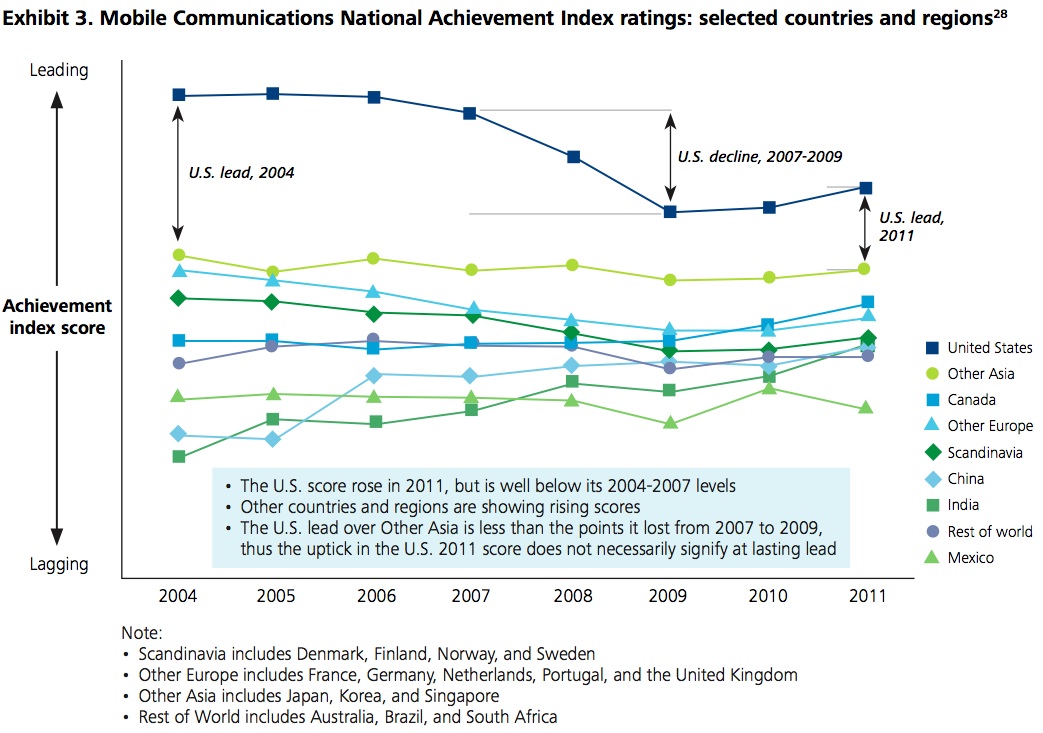Deloitte recently issued a new report on mobile broadband. It positions the U.S. as number-one and offers tips to keep it there, some more useful than others. There’s not much new for the mobile broadband expert. The collection of various mobile-spectrum policy issues into one document, however, could be useful to some, especially to those new to the field. Early on, Deloitte promises suggestions for improving U.S. spectrum policy; the suggestions, however, turn out to be mostly things we’ve heard before. There are a few problems with the report, discussed below, that readers should keep in mind.
Deloitte starts by emphasizing its view that the U.S. is the world leader in mobile broadband. As evidence of this, Deloitte debuts its Mobile Communications National Achievement Index. The index is said to track 20 countries using 15 mobile performance indicators such as data speeds, amount of carrier competition, and mobile penetration per capita. Based on its index, Deloitte makes the point that the U.S. lead is shrinking over time.
These types of country-by-country analyses vary depending on the assumptions used. Mobile analyst Tomi Ahonen, for example, maintains an index that currently ranks the U.S. #17 using a different set of inputs. In its recent annual report on broadband, the United Nations said the U.S. was #8 in mobile broadband penetration. Ahonen has speculated that Deloitte’s index is constructed to have a U.S. bias. Deloitte would like more business, and waving the flag will attract a certain kind of client.
Deloitte discusses how fewer large operators can benefit from economies of scale at the price to consumers of reduced competition. “End user needs are best met when the structure of the wireless industry combines choice and price competition with sufficient carrier scale to motivate and enable carriers to reduce costs, expand network coverage and capabilities, and invest in technology.” Put another way, there’s an optimum number of carriers but, disappointingly, Deloitte doesn’t take a crack at saying what it thinks that number should be.
Deloitte stumbles in the section on U.S. mobile broadband demand. It argues there is “exponential growth” in traffic, but the data cited do not exhibit exponential properties. Earlier this year, 4G Americas prepared a forecast, based on a global data forecast, suggesting that mobile data growth follows a logistic function more so than an exponential one. (In the same report, 4G Americas has also suggested mobile data growth could “saturate” in the year 2020.) Since the Deloitte report came out, CTIA has released data indicating a dramatic drop in U.S. mobile traffic.
Regardless of how fast, mobile data is growing. What’s driving that growth? Smart meters, in part, according to Deloitte. Smart meters, however, generally don’t use mobile broadband technology, and instead use unlicensed radio devices, often from the IEEE 802.15.4g family. In the Silver Spring Network’s press release Deloitte cites, there’s no way to tell which radio technology is being used but, I suspect further investigation would show it’s not mobile broadband. Some other applications Deloitte cites don’t strike me as rising to the level of a data tsunami: remote door unlocking, driving data sent to insurance companies to set rates, personal health records. It adds up, and when it does, the U.S. mobile broadband industry will respond.
There’s a section on what carriers are doing to increase capacity: Wi-Fi offload, small cells, next-generation radio rollout. Spectrum initiatives are discussed. The TV incentive auctions, spectrum sharing, repurposing federal spectrum for non-federal use.
Despite all that, Deloitte says, “mobile broadband demand growth threatens to overwhelm the system.” And, they start to lose me again. They cite a debunked FCC Technical Report on mobile broadband spectrum requirements. They’re pessimistic on Wi-Fi offload when indications are it’s working effectively today. They’re pessmistic on small cells, when Sprint has installed 900,000. Rate plans in which users increasingly pay for the data they use may be having some moderating effect; Deloitte says these help but do not prevent the need to increase capacity. Well, no one said they don’t. Rate plans, technology, small-cell topology, spectrum, are all part of addressing increased mobile data needs.
There’s some interesting discussion on local cell site approvals. Deloitte gets bonus points for discussing the split administration of federal and non-federal spectrum, and for citing the GAO report critical of NTIA processes.
Toward the end of the report Deloitte produces recommendations of varying utility, such as: “Developing an official U.S. spectrum strategy could provide the opportunity to resolve policy ambiguities.” No doubt, but I’d like to see something more unique and specific. Deloitte also suggests making the TV incentive spectrum auction a “top priority.” Seems to me it is.
It could be that my concerns are at least partly addressed elsewhere in the report, but I’ll plead Strunk & White if I missed them. A last criticism would be that the report should have had more editing. To get through it, one has to trudge through quite a bit of consultant-speak:
“A policy approach that recognizes the unique infrastructure aspects of spectrum and quantifies the potential returns and payback periods could help create sufficient momentum within both the private sector and government to help fund the costs of confronting technical challenges associated with making spectrum available on a timely basis.”
I get the point but some readers aren’t going to put up with that. That’s a shame because of the useful content they’ll miss. Make good use of your time by looking at the Executive Summary first, and being selective with the rest.
